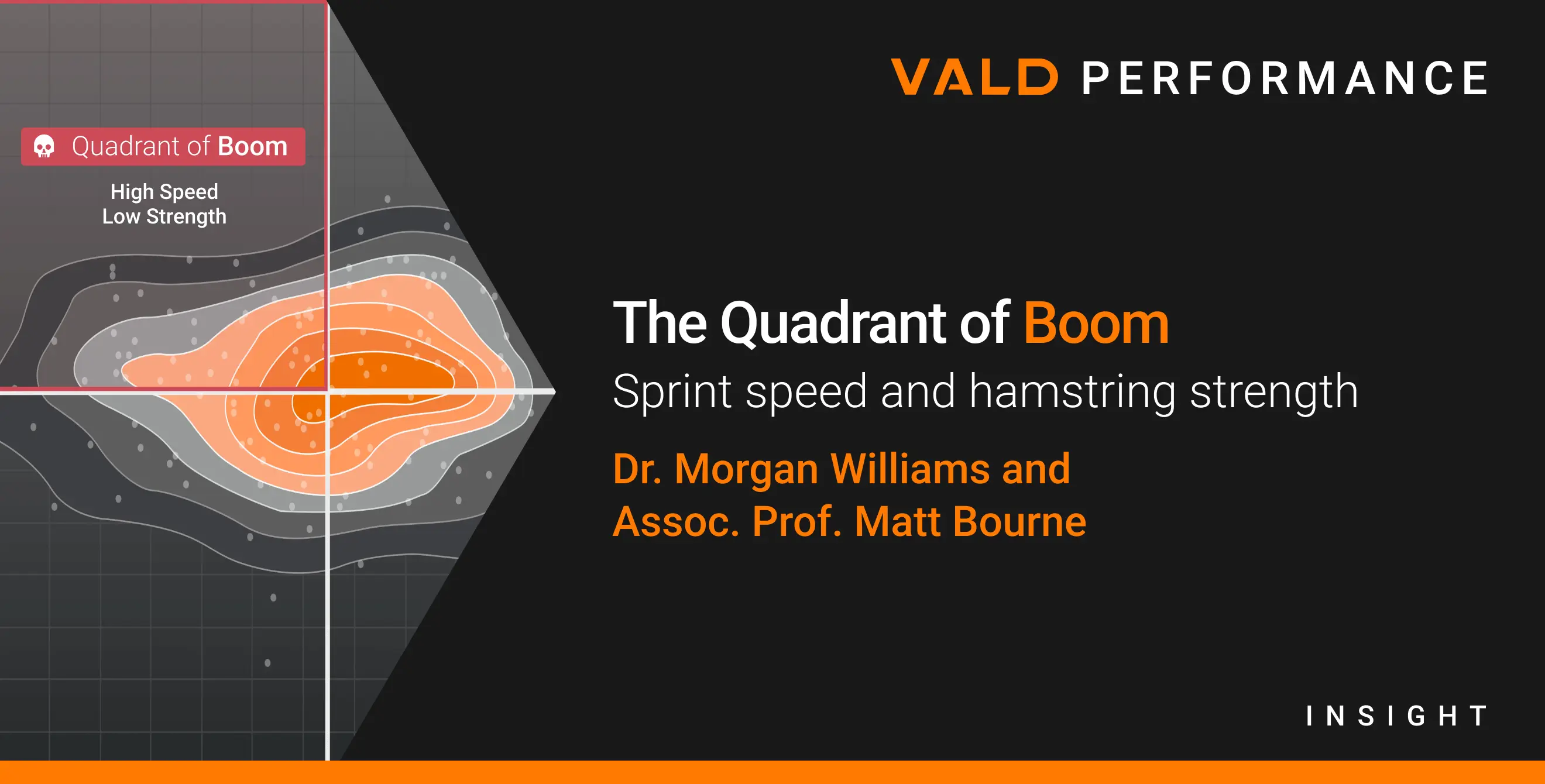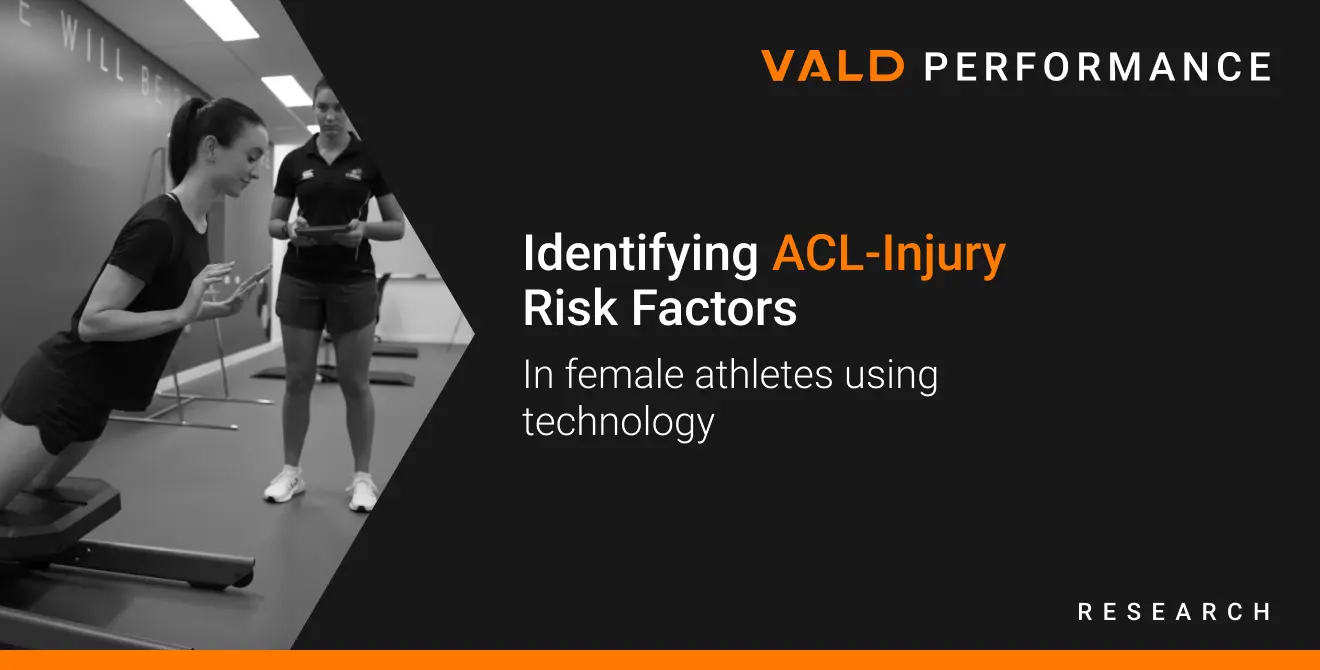Quadrant of Boom Part 2: Sprint momentum and hamstring strength
Available in:
EN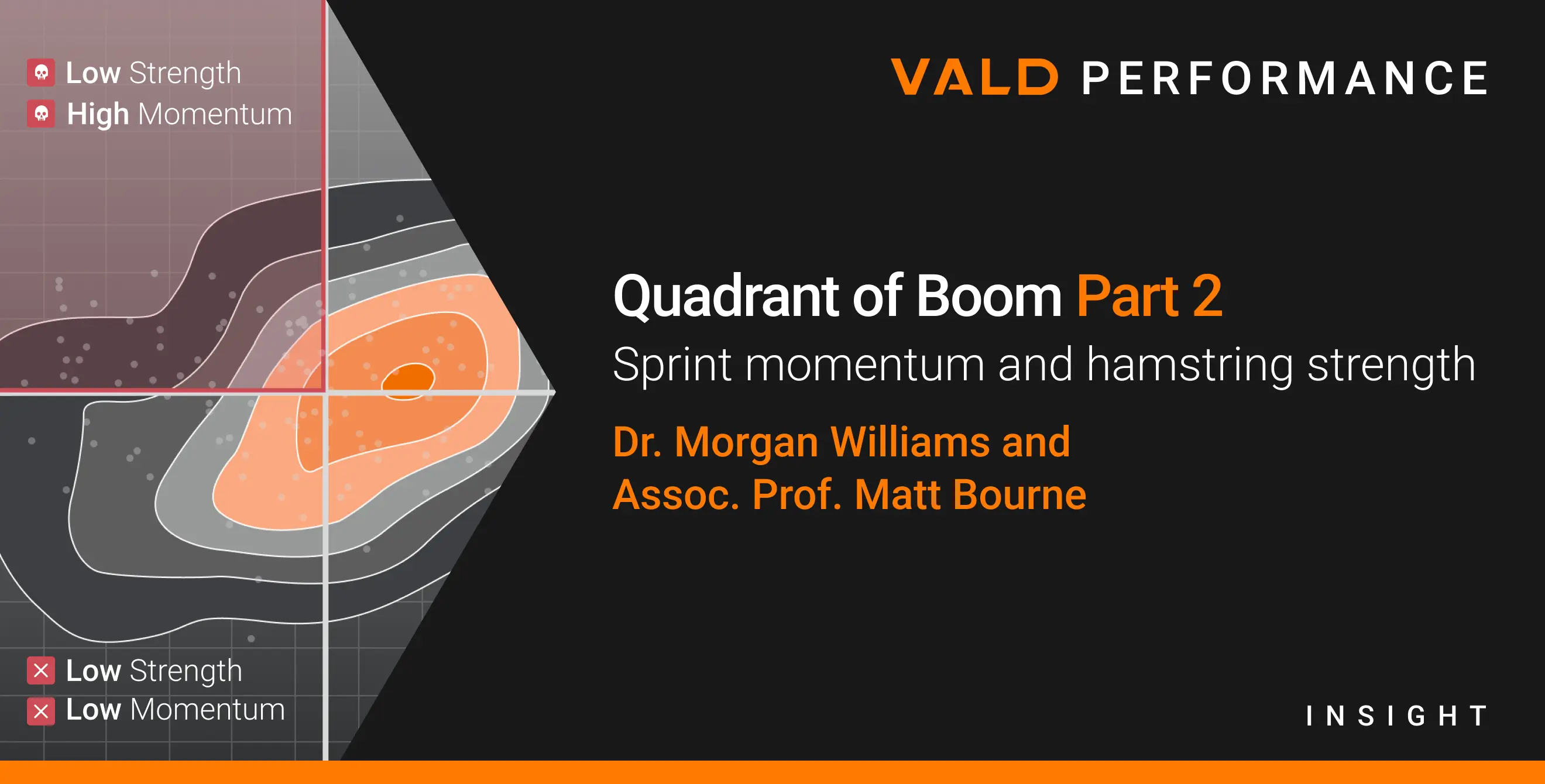
About the Authors
Dr. Morgan Williams is a Data Scientist at VALD and Adjunct Associate Professor at Griffith University’s School of Health Sciences and Social Work. As part of the VALD Data Science Team, he uncovers new insights into VALD data and how it can be used to enhance practice.
Associate Professor Matt Bourne is a Principal Research Fellow at Griffith University and spearheads the Precision Athlete research program at the Australian Centre for Precision Health and Technology. He leads a multidisciplinary research team focused on developing and applying innovative technologies to optimize performance and predict, prevent and recover from sports injuries.
As emphasized in our previous Quadrant of Boom article, it is unlikely that performance and injury risk – particularly in high-speed, high-impact scenarios – can be reduced to measures of sprint speed and eccentric hamstring strength alone.
While these are important metrics, there are many factors that need to be considered. They do, however, provide a useful starting point for initiating conversations and gaining a deeper understanding of an athlete’s level of fitness and preparedness for their activity of choice.
The Quadrant of Boom shows the relationship between sprint speed (peak velocity) and eccentric hamstring strength (peak Nordic force).
In this follow-up article, we continue exploring the value of eccentric hamstring strength and sprinting to inform practice, shifting the focus to acceleration over 10m and sprint momentum. Using rugby union as an example (though this can be extended to any sport or activity where rapid changes of direction occur), we examine how sprint momentum contributes to both performance and injury risk.
What Is Sprint Momentum?
…momentum produced from a standing start over 10m can be used to assess an athlete’s ability to generate force and speed.
In collision sports, the momentum produced from a standing start over 10m can be used to assess an athlete’s ability to generate force and speed. The metric is crucial in sports involving physical collisions (Barr et al., 2014). It is calculated by multiplying the average velocity (distance / time) over 10m by the athlete’s body mass.
Momentum matters – a lot. Athletes with higher sprint momentum are thought to better withstand and deliver impacts during tackles. This makes them more effective ball carriers, better at breaking tackles and at dominating physical confrontations on the field.
Momentum matters…athletes with higher sprint momentum…[dominate] physical confrontations on the field.
The summary below – adapted from Hart et al. (2023) – identifies the many contributing factors associated with ball carrying capability in rugby union. There is a clear emphasis on speed, body composition, body mass and thus sprint momentum.
Bigger, Stronger, Faster – but Safer?
Rugby union became a professional sport in 1995, and since then, athletes have become noticeably bigger and faster (Bevan et al., 2022). Bigger and faster athletes might have an advantage in physical confrontations, but the downside is that these bigger, faster bodies now create much higher forces, potentially exacerbating contact and non-contact injury risk.
Bigger and faster athletes might have an advantage in physical confrontations, but the downside [could be]…exacerbating contact and non-contact injury risk.
Non-contact injuries are a significant concern in sports, since they are a major cause of time-loss from training and competition and are considered preventable through appropriate training and physical preparation.
Among these, anterior cruciate ligament (ACL) ruptures are particularly severe and increasingly common, often leading to long-term consequences such as surgery, extensive rehabilitation and an increased risk of re-injury and early-onset osteoarthritis.
ACL ruptures often occur during sudden deceleration, cutting or changes of direction – movements that occur when athletes attempt to avoid contact. At high speeds and with high momentum, these movements can place excessive stress on the knee, pushing the ACL beyond its structural limit (Della Villa et al., 2021).
From an injury risk perspective, athletes with the capacity to generate high levels of momentum – typically larger athletes who can move at high speeds – may face greater challenges in stabilizing the knee during rapid changes of direction, further exacerbating their risk of injury.
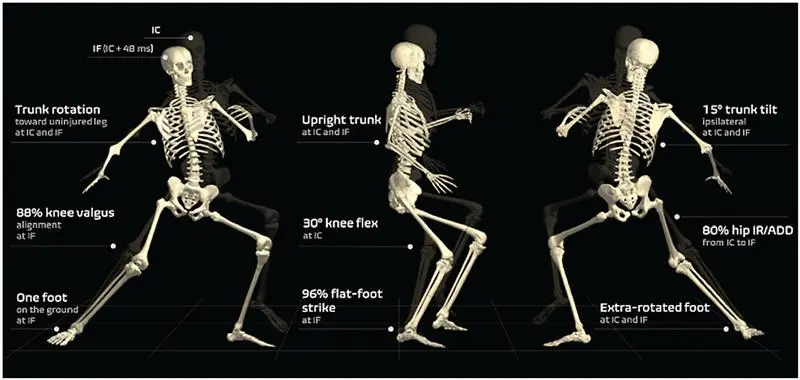
Body positions and movement patterns associated with ACL rupture risk, reprinted from Lucarno et al. (2021).
The Role of the Hamstrings in Stabilizing the Knee
Knee stabilization involves a combination of feedforward planning, muscular, ligamentous and neuromuscular control mechanisms. Consequently, muscles that counteract anterior shear forces and external valgus moments are key for protecting the ACL from injury during high-risk maneuvers.
Hamstrings represent the primary form of muscular support for the ACL. Based on advanced computational modelling, Maniar et al. (2018) showed that the biceps femoris long head and medial hamstrings provide up to 111N and 77N, respectively, of posterior shear force during side-step cutting, directly opposing anterior tibial translation.
Muscles that oppose anterior tibial translation during side-step cutting.
Furthermore, recent findings from Collings et al. (2022) indicate that between-limb asymmetry in eccentric Nordic strength is an independent risk factor for ACL injury in elite female footballers. Collectively, these findings highlight the potential importance of including eccentric hamstring training and testing in ACL prevention programs.
…these findings highlight the…importance of including eccentric hamstring training and testing in ACL prevention programs.
That said, eccentric hamstring strength and sprint momentum are just part of a multifactorial risk profile. While beyond the scope of this blog, future research may benefit from comprehensive lower limb muscle strength and biomechanics assessments, such as those described by Collings et al. (2022), to better identify individual risk.
Notably, the combination of lower limb muscle strength and biomechanics assessments in that study successfully classified four out of five subsequent ACL injuries.
Building the Quadrant of Boom 2
The 10m distance used to calculate momentum represents the confined space in competition and training where athletes frequently have to generate short, sharp bursts of intense movements.
[The Quadrant of Boom 2 tells you]…how hard an athlete can potentially hit [and] how well they are equipped to handle…changes of direction.
By plotting an athlete’s 10m sprint momentum against their peak eccentric hamstring strength, we gain a clearer picture of not just how hard an athlete can potentially hit, but how well they are equipped to handle rapid movements and sharp changes of direction. This insight brings us to the evolution of our visualization tool: the Quadrant of Boom 2.
To create this tool, you will need three measures:
- 10m sprint time, obtained from the initial 10m split of a 40m sprint test using SmartSpeed or similar technology
- Peak Nordic force, measured using NordBord
- Body mass
Once you have these measures, we can:
- Calculate the 10m velocity (i.e., 10m / sprint time)
- Use that velocity to calculate sprint momentum (10m velocity [m/s] x body mass [kg])
- Plot sprint momentum against peak Nordic force
Below is an example using a dataset collected as part of the Welsh Rugby Union (WRU) Schools and Colleges League project, supported by the University of South Wales.
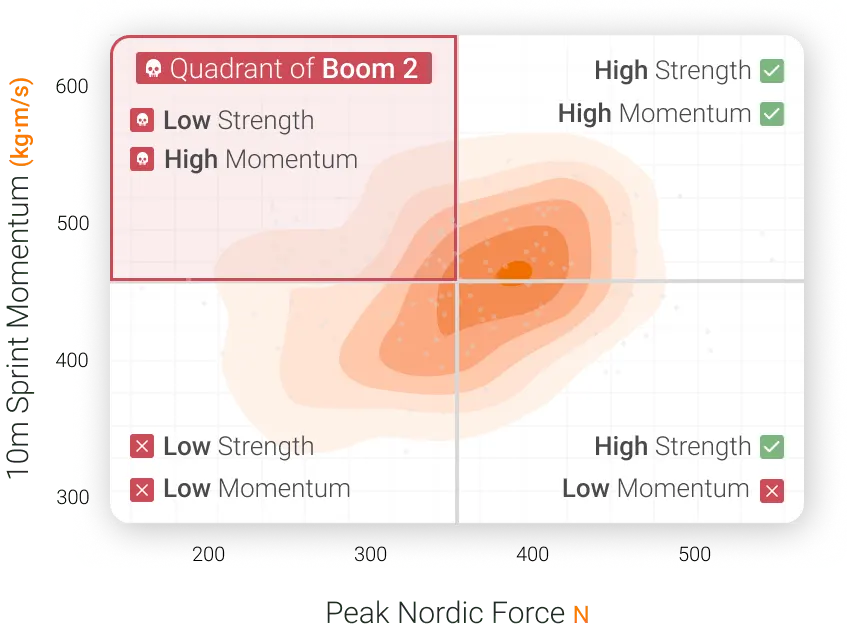
The table below provides interpretations for each of the resulting quadrants.
Moving Forward
The Quadrant of Boom 2 is an evolution in how we think about sprinting, strength, performance and risk of injury. By substituting peak velocity for 10m sprint momentum, we offer a perspective on athlete readiness. Although it does not capture the full complexity of injury risk, it may offer a powerful and practical starting point by leveraging measures that are routinely collected.
Ultimately, the conversation we want to spark is simple: Is the athlete equipped to handle the momentum they can generate?
If you would like to learn more about how you can leverage SmartSpeed and NordBord testing to enhance your practice, please reach out here.
References
- Barr, M. J., Sheppard, J. M., Gabbett, T. J., & Newton, R. U. (2014). Long-term training-induced changes in sprinting speed and sprint momentum in elite rugby union players. The Journal of Strength & Conditioning Research, 28(10), 2724–2731. https://doi.org/10.1519/jsc.0000000000000364
- Hart, A. S., Erskine, R. M., & Clark, D. R. (2023). The use of physical characteristics to explain variation in ball-carrying capability in elite rugby union: a narrative review. The Journal of Strength & Conditioning Research, 37(8), 1718–1727. https://doi.org/10.1519/jsc.0000000000004468
- Bevan, T., Chew, S., Godsland, I., Oliver, N. S., & Hill, N. E. (2022). A game for all shapes and sizes? Changes in anthropometric and performance measures of elite professional rugby union players 1999–2018. BMJ Open Sport & Exercise Medicine, 8(1). https://doi.org/10.1136/bmjsem-2021-001235
- Della Villa, F., Tosarelli, F., Ferrari, R., Grassi, A., Ciampone, L., Nanni, G., Zaffagnini, S., & Buckthorpe, M. (2021). Systematic video analysis of anterior cruciate ligament injuries in professional male rugby players: Pattern, injury mechanism, and biomechanics in 57 consecutive cases. Orthopaedic Journal of Sports Medicine. 9(11). https://doi.org/10.1177/23259671211048182
- Lucarno, S., Zago, M., Buckthorpe, M., Grassi, A., Tosarelli, F., Smith, R., & Della Villa, F. (2021). Systematic Video Analysis of Anterior Cruciate Ligament Injuries in Professional Female Soccer Players. The American Journal of Sports Medicine, 49(7), 1794–1802. https://doi.org/10.1177/03635465211008169
- Maniar, N., Schache, A. G., Sritharan, P., & Opar, D. A. (2018). Non-knee-spanning muscles contribute to tibiofemoral shear as well as valgus and rotational joint reaction moments during unanticipated sidestep cutting. Scientific Reports, 8(1), 2501. https://doi.org/10.1038/s41598-017-19098-9
- Collings, T. J., Diamond, L. E., Barrett, R. S., Timmins, R. G., Hickey, J. T., du Moulin, W. S., Williams, M. D., Beerworth, K. A., & Bourne, M. N. (2022). Strength and biomechanical risk factors for noncontact ACL injury in elite female footballers: A Prospective Study. Medicine and Science in Sports and Exercise, 54(8), 1242–1251. https://doi.org/10.1249/mss.0000000000002908
